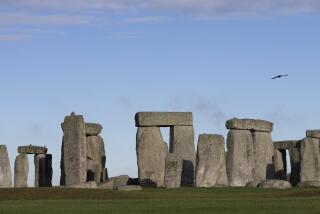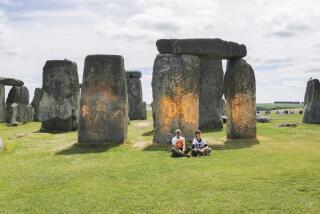Discovery sheds new light on Stonehenge
- Share via
British archaeologists have found the remains of a massive stone henge, or ceremonial circle, that was part of the ancient and celebrated Stonehenge complex, a find that is shedding new light on how the monument was built and its religious uses.
The new henge, called Bluestonehenge because it was built with blue Preseli dolerite mined more than 150 miles away in Wales, was on the banks of the River Avon, where ancient pilgrims carrying the ashes of their dead relatives began the journey from the river to Stonehenge, nearly two miles away. Some are calling it the “little sister” of Stonehenge.
The approximately 25 massive bluestones were erected in a circle about 5,000 years ago, and eventually were encircled by a ditch and an earthen embankment.
About 500 years later, however, the stones were moved and incorporated into Stonehenge itself.
All that is left of the circle are the holes where the stones sat in the ground and a few chips of dolerite.
The fact that the monument was found at the beginning of an avenue leading to Stonehenge and near the river “not only solidifies the view that Stonehenge covers the entire landscape, but also the sacred importance of the river itself,” said archaeologist Christine Hastorf of UC Berkeley, who was not involved in the research.
“It means that there was a link between Stonehenge and the water, out to the ocean,” she said.
Stonehenge is made up of concentric circles of massive stones, some weighing as much as 50 tons, surrounded by a ditch and an earthen bank. The structure is aligned with sunrise on the summer solstice, and researchers have long viewed it as both an astronomical observatory and a cemetery.
A team led by archaeologist Michael Parker Pearson of the University of Sheffield made the discovery while excavating in the area of Stonehenge during the last several years.
Its findings have suggested that the entire site, which stretched from the river to Stonehenge, was a religious complex where ancient peoples gathered at certain times of the year to celebrate life and bury their dead.
Some of their discoveries have also suggested that Stonehenge was a burial site for early kings.
The team had long suspected there was some kind of monument near the river at the beginning of the avenue leading to Stonehenge, but it had great difficulty finding it, Parker Pearson said in a telephone interview Monday.
“We tried every method we could to prospect for the circle -- radar, magnetic signals, electrical resistance in the Earth -- but we couldn’t see anything there at all.”
Only when they began digging in August and September did they find what they were looking for.
So far, they have found nine holes that they believe were part of a 30-foot-wide circle of about 25 standing stones.
The holes are too wide and shallow for them to have contained wooden posts.
The holes are also too small to have held sarsen stones, the larger limestone rocks that form part of Stonehenge and that were mined at Marlborough Downs 25 miles to the north.
But the dimensions correlate precisely with those of bluestones in the inner circle of Stonehenge.
The stone circle at Bluestonehenge was eventually replaced by a henge, a circular ditch nearly 74 feet across with an external bank.
Little trace of the bank remains except at one place where it was pushed back into the ditch. Elsewhere, the ditch filled with silt and sediment over thousands of years.
Broken antler pickaxes in the ditch date its construction to about 2470 BC to 2280 BC. At least one entrance has been discovered, on the east side, and it contained a specially placed deposit of antlers, an antler pickaxe, cattle bones and stone and flint tools.
After the ditch had filled with silt, its northern quadrant was recut during the Bronze Age, which lasted from 2300 BC to 600 BC in Europe. During the medieval period, particularly during the 13th century, a complex series of east-west and north-south trenches were dug and filled. Their purpose is unknown.
The team also found the riverside end of the avenue to Stonehenge. It was marked by two parallel ditches about 54 feet apart. These originally held posts, forming a small palisade on either side. The avenue apparently terminated at or close to the outer bank of the newly discovered henge.
Archaeologist Josh Pollard of Bristol University, a co-director of the project, noted that the circle “should be considered an integral part of Stonehenge rather than a separate monument, and it offers tremendous insight into the history of its famous neighbor.”
Previous research had shown that Stonehenge originally consisted of 56 bluestones set in a circle inside a ditch and bank. Sometime about 2500 BC, those stones were moved to their current location, leaving behind the holes now known as Aubrey holes.
But there are 80 bluestones in Stonehenge and only 56 Aubrey holes, Parker Pearson said.
“Where did the other 24 stones come from? I think we have solved that problem. They uprooted the other circle and moved the stones. Why they did it, we don’t know.”
But “what it tells us for sure is that the river is essential to understanding Stonehenge,” Parker Pearson added, because why else would the ancient builders have erected a monument there?
Burning ceremonies appear to have been important rites at the site as well. When the stones at Bluestonehenge were pulled out, a lot of topsoil fell in, and that topsoil, the team found, is full of charcoal.
“They were building a lot of fires there. That may have been where they were cremating bodies” before burying them at Stonehenge, Parker Pearson said.
“This is a very exciting time,” he added. “Our seven years of work have completely rewritten the story of Stonehenge.”
But the work is not done. For example, Parker Pearson said the team thinks it has located the quarry where the sarsen stones were excavated and is now working to confirm the identification.
It is also using isotopic analysis of teeth from cattle that were eaten during the large celebrations at the site and during its construction to determine where the animals came from.
“The vast majority are coming from long distances away,” many of them from Wales or southwest England, he said. “There was a very large [number] of animals being brought to support the population building Stonehenge.”
The discovery was announced Monday by the National Geographic Society, which funded much of the research.
Full details will be published in February, Parker Pearson said.
More to Read
Sign up for Essential California
The most important California stories and recommendations in your inbox every morning.
You may occasionally receive promotional content from the Los Angeles Times.










